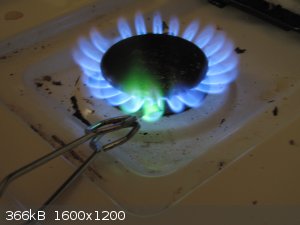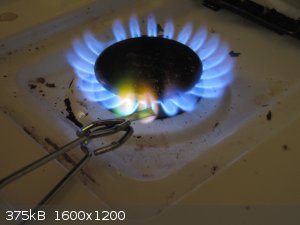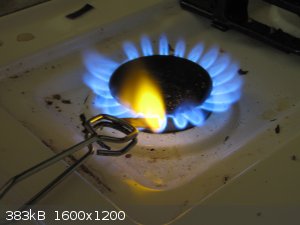homeschoolmadness
Harmless

Posts: 4
Registered: 3-7-2019
Member Is Offline
|
|
Copper flame test - why does green disappear?
I'm a homeschooling mom teaching a co-op chemistry class, and I am testing out materials for doing flame tests in class. I found that a small piece
of copper flashing, and a pre-1982 penny, both give off a bright green flame. Not blue/green, like the flame test color charts say, but a bright,
true green, greener than it looks in this photo. Great for a classroom demo, I thought! But in about 30 seconds, the green color faded and the
sample gave off a bright orange color. When it's re-heated, the sample no longer gives off the green color.
Did the copper change from copper (II) to copper (III) (or vice-versa) upon cooling? As it cooled, I noticed the copper oxidized to a pinkish,
slightly charred color.
I will use copper flashing and pennies in my classroom, since it gives off the best green color I have found. I would like to be able to explain the
phenomenon to my students, though.
Chemistry was actually my weakest subject, but no other mom in my co-op is going to teach it, so I will forge ahead, and thank anyone who can help me
with this one.
  
|
|
|
DraconicAcid
International Hazard
    
Posts: 4333
Registered: 1-2-2013
Location: The tiniest college campus ever....
Member Is Offline
Mood: Semi-victorious.
|
|
You get the green colour when copper compounds get volatilized in the flame. It goes away when the copper compounds are used up. The copper itself
isn't copper(I) or copper(II) unless it's in a compound.
If you want the greeniest green from copper, you want copper(I) or copper(II) chloride coating your wire rather than the oxide. Halides make it
greener than blue. If you dip your copper in hydrochloric acid and let it dry in air, that should give you a coating.
Please remember: "Filtrate" is not a verb.
Write up your lab reports the way your instructor wants them, not the way your ex-instructor wants them.
|
|
|
homeschoolmadness
Harmless

Posts: 4
Registered: 3-7-2019
Member Is Offline
|
|
Thank you, DraconicAcid! I tried cleaning my pieces of copper flashing in vinegar/salt before, but I didn't let my them dry... I just now re-tried
the pieces I cleaned a few days ago, but gave up on, and they do give off a nice color. Now I have an explanation, AND I know how to make my copper
pieces re-usable! Double thanks.
|
|
|
Sulaiman
International Hazard
    
Posts: 3695
Registered: 8-2-2015
Location: 3rd rock from the sun
Member Is Offline
|
|
Salt = sodium chloride
sodium gives a very intense yellow flame.
Try cleaning the copper with an abrasive sponge/cloth/paper and definitely avoid anything with sodium in it. (e.g. glass)
CAUTION : Hobby Chemist, not Professional or even Amateur
|
|
|
Morgan
International Hazard
    
Posts: 1694
Registered: 28-12-2010
Member Is Offline
Mood: No Mood
|
|
That made me think of those butane lighters that burn with the longer lasting vivid green flame,
https://www.quora.com/Why-does-my-lighter-produce-a-green-fl...
[Edited on 4-7-2019 by Morgan]
|
|
|
Herr Haber
International Hazard
    
Posts: 1236
Registered: 29-1-2016
Member Is Offline
Mood: No Mood
|
|
If you have access to a couple alcohol lamps you could even fill them with alcohol and a salt that would impart a color.
There are videos showing that exact experience on Youtube.
I suppose you could find solution to clean contact lenses. It's usually a weak borax solution (that you might also have in your kitchen) and will also
give a green color.
Now where to get lithium for a nice pink flame ?
The spirit of adventure was upon me. Having nitric acid and copper, I had only to learn what the words 'act upon' meant. - Ira Remsen
|
|
|